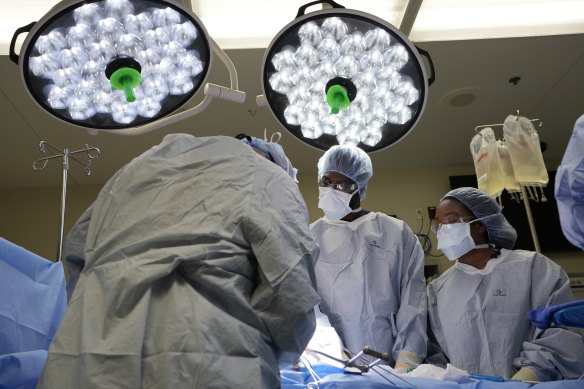Save articles for later
Add articles to your saved list and come back to them any time.
New York: A new method for retrieving hearts from organ donors has ignited a debate over the blurry line between life and death.
At the heart of the debate is whether there is any possibility that donors might still experience some trace of consciousness or pain as their organs are harvested.
Most heart donations currently come from a small category of deaths: donors who have been declared brain-dead, often after a traumatic incident like a car crash, but who remain on life support – their heart beats, and their blood circulates bringing oxygen to their organs – until a transplant team recovers their organs.
Brianne and Colin, children of firefighter Billy Moon, listen to the beating of their father’s heart inside transplant recipient Richard Grehl for the first time at the offices of LiveOnNY in New York earlier this month.Credit: AP
The new technique, transplant surgeons say, significantly expands the potential pool of donated hearts to patients who are comatose but not brain-dead, and whose families have withdrawn life support because there is little chance of recovery. Normally after these patients’ hearts stop, they would be declared dead, but their hearts are rarely recovered because they are often damaged by oxygen depletion during the dying process.
Surgeons have discovered that returning blood flow to the heart, after the donor has been declared dead, restores it to a remarkable degree, making it suitable for transplant. If adopted more widely, the method will significantly increase the number of hearts available for transplantation, saving lives.
But two aspects of the procedure have left some surgeons and bioethicists uncomfortable.
Medical College students watch as the liver and kidneys are removed from an organ donor in Jackson, Tennessee, in June.Credit: AP
The first problem stems from the way death has traditionally been defined: the heart has stopped and circulation of blood has irreversibly ceased. Because the new procedure involves restarting blood flow, critics say it essentially invalidates the earlier declaration of death.
But that may be a minor problem compared to an additional step surgeons take. They use metal clamps to cut blood flow from the revived heart to the donor’s head, to limit blood flow to the brain to prevent the possibility that any brain activity is restored. Some physicians and ethicists say that is a tacit admission that the donor might not be legally dead.
“It’s kind of a creepy thing to be doing,” a longtime US heart surgeon and transplant specialist, Dr V Eric Thompson, said.
The new method has been championed by New York University Langone Health in Manhattan, which says it became the first hospital in the United States to try it in 2020.
It has used the procedure, which uses a cardiopulmonary bypass machine, to recover nearly 30 hearts that would not otherwise have been transplanted.
And some medical groups have flat-out opposed it. The American College of Physicians has said clamping the arteries to the brain to ensure brain death while restarting circulation appears to violate “the dead donor rule” – a foundational tenet of organ transplantation in the United States to ensure organ procurement is not the cause of a donor’s death.
The NewYork-Presbyterian Hospital, which has the city’s largest organ transplant program, rejected the technique after it was examined by an ethics committee.
This article originally appeared in The New York Times.
Most Viewed in World
From our partners
Source: Read Full Article




